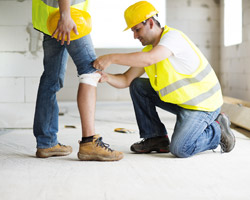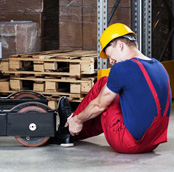Your Rights After a Construction Accident
Recovering Full and Fair Compensation for a Construction Site Injury
 Residential and commercial construction sites are among the most dangerous places to work in the United States. In addition to the prevalence of high-powered tools and heavy equipment, there’s typically pressure to complete the project quickly in order to maximize profitability. It should come as no surprise, then, that the Occupational Safety and Health Administration (OSHA) found that construction workers have a 70% higher risk of sustaining a work-related injury than any other occupation.
Residential and commercial construction sites are among the most dangerous places to work in the United States. In addition to the prevalence of high-powered tools and heavy equipment, there’s typically pressure to complete the project quickly in order to maximize profitability. It should come as no surprise, then, that the Occupational Safety and Health Administration (OSHA) found that construction workers have a 70% higher risk of sustaining a work-related injury than any other occupation.
Facts and Statistics About Construction Accidents in the United States
Data collected by OSHA demonstrates just how dangerous a construction site can be:
- Approximately one of every 10 construction workers suffers some type of job-related injury each year—That equates to about 200,000 injuries annually.
- On average, 20% of all work-related deaths in the United States happen on a construction site—In 2017, approximately 10 of every 100,000 construction workers died on a job site.
- Over 6% of all lost worker days in the country are in the construction industry.
- Construction site injuries are significantly underreported—About one in four construction workers choose not to report a work-related injury.
Types of Construction Accidents
The most common, and most dangerous, types of construction site accidents are referred to as the “fatal four.” They account for nearly two of every three construction site fatalities:
- Falls from heights—Workers may fall from ladders, scaffolding, cranes, buckets, roofs, or upper levels on construction projects.
- Falling objects—Workers may be struck by falling construction materials, tools, machinery, jobsite debris, and even other workers.
- Electrocution—Workers may be injured by exposure to live electrical current, contact with outside power lines, or the failure to properly ground electrical wires.
- “Caught-between” accidents—Workers may be crushed or pinned by equipment, machinery, or building materials.
Other construction site injuries run the gamut, including:
- Injuries caused by the breakdown, malfunction, or improper operation of tools, equipment, or machinery
- Slips, trips, and falls, often related to jobsite debris or tools left lying around
- Motor vehicle accidents involving heavy equipment, construction site trucks, or other vehicles
- Ground collapses, typically tied to excavation operations
- Repetitive stress or motion injuries
Common Causes of Construction Accidents
The sad reality is that virtually all construction site accidents can be avoided. The most common causes of injury on a construction site are:
- The failure to provide appropriate safety precautions, such as adequate barriers to prevent workers or construction objects from falling from heights
- Failure to monitor the jobsite for tripping hazards and remove them
- Missing guards or other safety precautions on power tools, machines, or equipment
- Dangerous or defective design or manufacture of jobsite tools, equipment, or machinery
- Negligence or carelessness in hiring, training, or supervising employees
- Failure to take proximity to power lines or other electricity sources into account
The Role of OSHA in Regulating Construction Sites in the United States
OSHA maintains safety standards for the construction industry. The agency also conducts inspections without advance notice, though employers may require an inspection warrant before allowing inspectors on the premises. Based on those inspections, as well as complaints filed with the agency and other investigations, OSHA may cite contractors, owners and others for violation of safety regulations. Such violations can carry substantial fines.
Protecting Your Legal Rights After a Construction Site Accident
If you’re hurt on a jobsite because of the carelessness or negligence of another person, you have the right to take legal action to recover for your losses. In most instances, employers are required to carry a policy of workers’ compensation insurance (though some states allow employers to be “self-insured”). To recover workers’ comp benefits, you need only show that you were injured and that the injury occurred in the course of your employment. You don’t have to file a lawsuit to recover for losses that are covered by workers’ compensation. You can submit a claim for benefits directly to your employer’s workers’ compensation insurance carrier. Workers’ compensation laws identify specific dollar amounts workers receive based on the type of injury.
It’s important to understand, though, that workers’ compensation applies only to injuries caused by your employer or a coworker. If you suffer injury because of the wrongful acts of an unrelated third party, you’ll need to file a personal injury lawsuit to recover damages. An example of a situation where you might need to file a “third party claim” would be if your injury is caused by a defective tool or machine, in which case you will need to sue the manufacturer. You can file a workers’ compensation claim simultaneously with a third-party lawsuit. You cannot, however, recover for the same losses in both proceedings.
Improving Construction Site Safety
A number of simple measures can be implemented to dramatically reduce the risk of injury on a construction site:
- Employers can make safety the top jobsite priority, which might involve regular safety inspections, meaningful safety training, and periodic safety meetings.
- Employers can get workers involved in the process and provide incentives for following safety protocol.
Summary
Construction sites are among the most dangerous places to work, with potential risk of injury due to falling objects, falls from heights, dangerous or defective equipment, exposure to electrical current, and carelessness by coworkers. After a construction site injury, a worker can usually seek damages through a workers’ compensation claim. If any injuries were caused by outside vendors or other third parties, the worker may also be able to simultaneously file a personal injury lawsuit to recover damages not covered by workers’ comp.
Connect with Top-rated Attorneys Near You
Sponsored Advertisement
Other Personal Injury Law Center Topics
Damages
Your Rights When You Have Been Injured by a Dangerous or Defective Product
Adderall and Ritalin
Protecting Your Legal Rights After a Car Accident
Defective Drug Claims
Defective Drugs and Medical Devices Law Center
Dog Bites
Fosamax
Hormone Replacement Therapy
Ketek
Kugel Mesh Patch
Recovering Compensation After Medical Malpractice
Medtronic Defibrillators
Medtronic Pacemakers
Understanding Negligence in a Personal Injury Claim
Neurontin
Nursing Home Neglect and Abuse
Ortho Evra
Other Personal Injury
Other Professional Malpractice
Your Rights in a Premises Liability Claim
Prempro
Seroquel
Sulzer Hip Implants
Toxic Tort
Trucking Accidents
Wrongful Death
Zyprexa
Defective Drugs & Medical Devices
Latest Article
What Is a Trust Fund? A Comprehensive Guide
A trust fund is a powerful tool that has stood the test of time. It is an essential instrument in modern wealth manageme... Read More
Arraignment: Meaning, Common Charges, & Process
Arraignment is a pivotal moment within the criminal justice system, marking the formal initiation of criminal proceeding... Read More
What Is Probable Cause? Definition and Examples
The Constitution protects you from being searched without a valid reason. But what exactly constitutes a valid reason? A... Read More
GETLEGAL®ATTORNEY DIRECTORY
Find Leading Attorneys in Your Area
NEED PROFESSIONAL HELP?
Talk to an Attorney
How It Works
- Briefly tell us about your case
- Provide your contact information
- Choose attorneys to contact you





